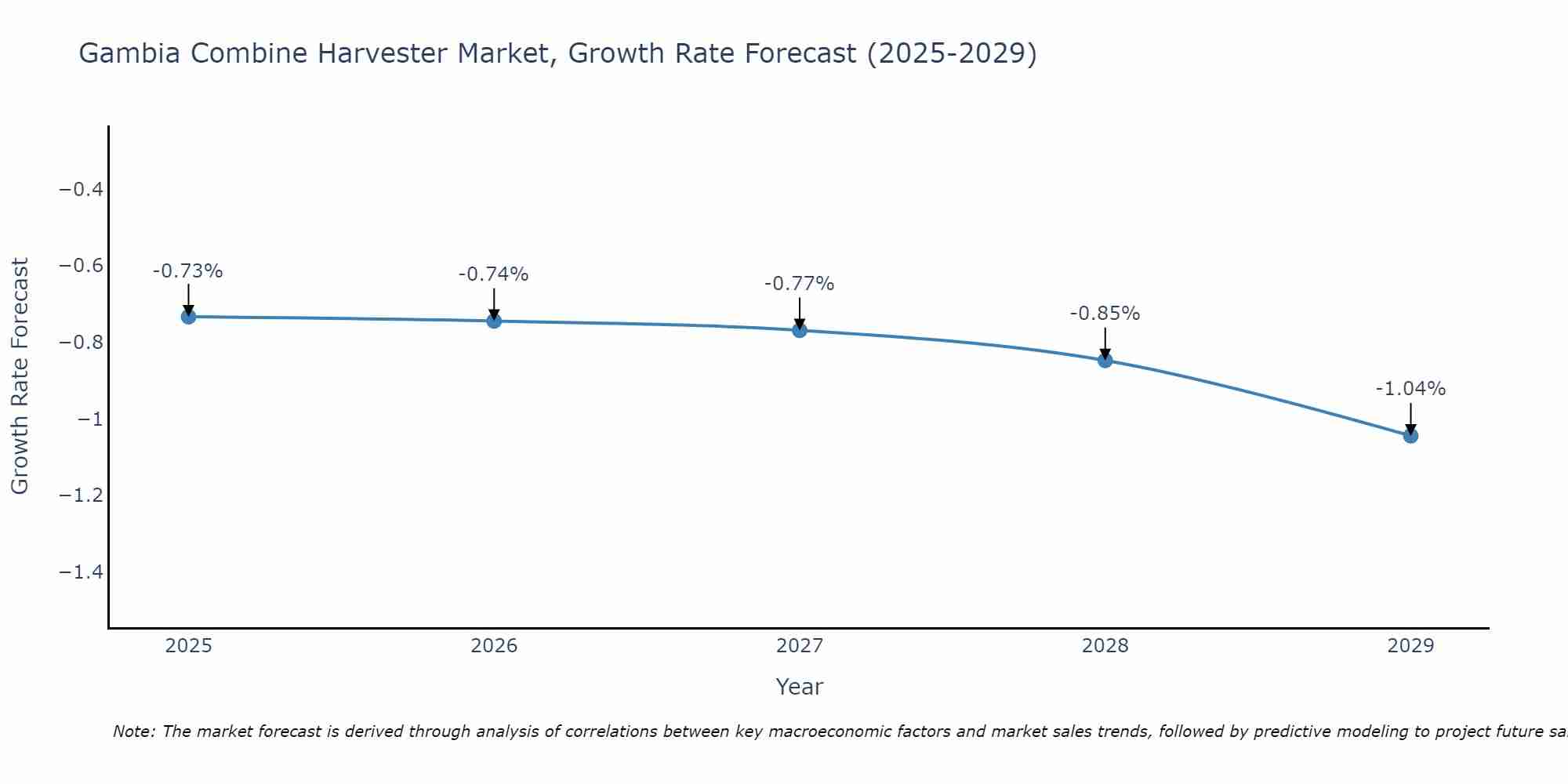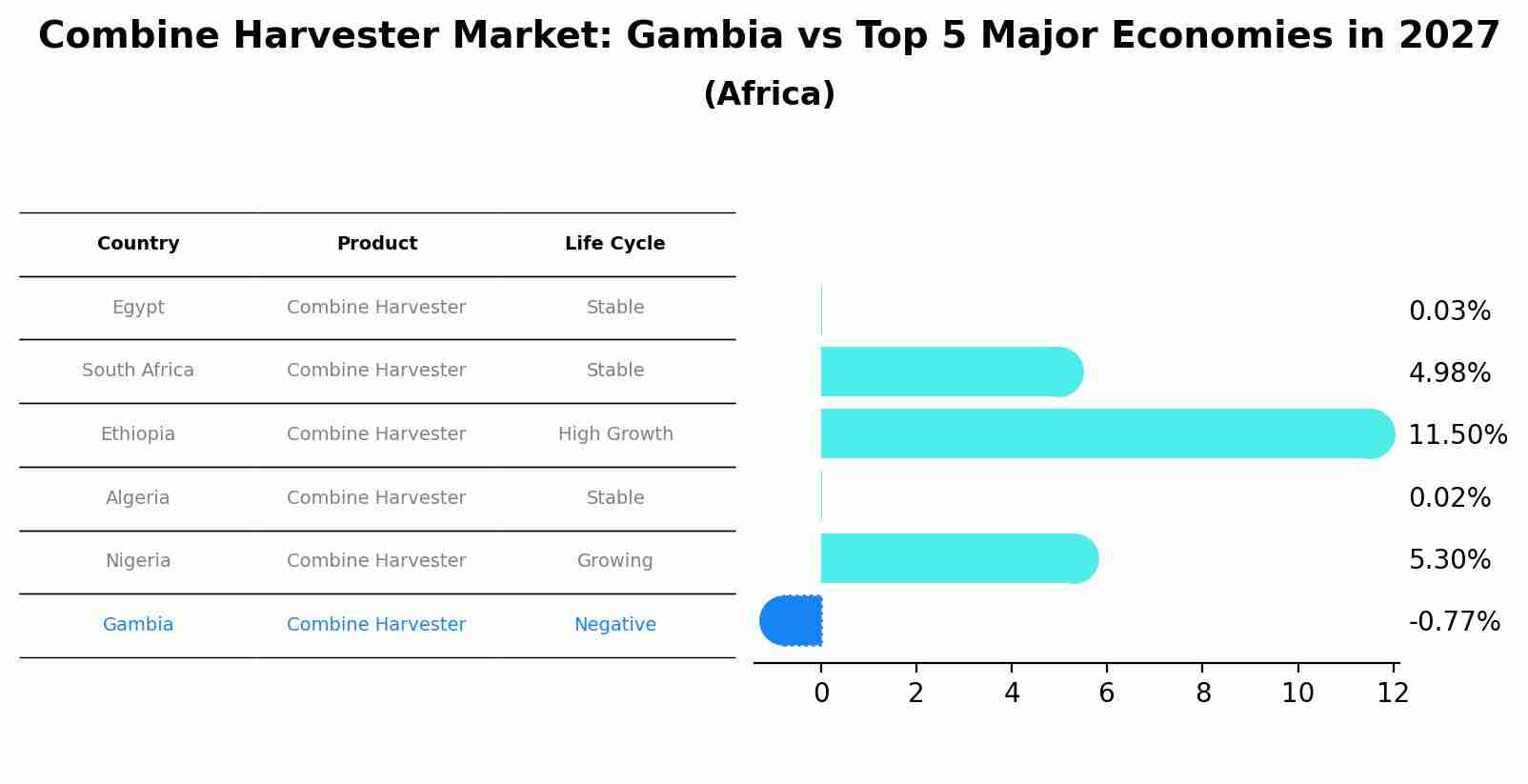Gambia Combine Harvester Market (2025-2031) | Segmentation, Industry, Companies, Trends, Share, Value, Forecast, Analysis, Size, Outlook, Revenue & Growth
| Product Code: ETC5398241 | Publication Date: Nov 2023 | Updated Date: Aug 2025 | Product Type: Market Research Report | |
| Publisher: 6Wresearch | Author: Bhawna Singh | No. of Pages: 60 | No. of Figures: 30 | No. of Tables: 5 |
Gambia Combine Harvester Market Size Growth Rate
The Gambia Combine Harvester Market may undergo a gradual slowdown in growth rates between 2025 and 2029. Beginning strongly at -0.73% in 2025, growth softens to -1.04% in 2029.

Combine Harvester Market: Gambia vs Top 5 Major Economies in 2027 (Africa)
Gambia's Combine Harvester market is anticipated to experience a negative growth rate of -0.77% by 2027, reflecting trends observed in the largest economy Egypt, followed by South Africa, Ethiopia, Algeria and Nigeria.

Gambia Combine Harvester Market Overview
The combine harvester market in Gambia is set to grow as the agriculture sector becomes more mechanized to meet the demands of modern farming practices. Combine harvesters are crucial for increasing the efficiency and productivity of crop harvesting. As Gambia`s agricultural sector modernizes and seeks to improve crop yields, the demand for combine harvesters will rise, supported by government initiatives aimed at boosting agricultural productivity and ensuring food security.
Drivers of the market
The combine harvester market in Gambia is expanding as the agricultural sector modernizes. With the increasing need for efficient crop harvesting methods, combine harvesters offer significant benefits, such as saving time and improving productivity. Gambia`s agriculture sector, which plays a key role in its economy, is gradually transitioning towards mechanized farming, and this trend is expected to drive demand for combine harvesters. Government initiatives to improve agricultural productivity and the rising demand for food security will further bolster the growth of this market.
Challenges of the market
The combine harvester market in Gambia is restricted by the countrys predominantly small-scale and subsistence farming practices. Most farmers rely on manual labor or basic farming tools, and the high cost of purchasing and maintaining combine harvesters is unaffordable for many. The lack of mechanized farming adoption, coupled with limited access to financing options and a lack of local servicing infrastructure, hinders the growth of the combine harvester market.
Government Policy of the market
The Gambia government may introduce policies aimed at boosting agricultural productivity by supporting the adoption of modern farming equipment, such as combine harvesters. This could involve providing subsidies or low-interest loans to farmers for purchasing combine harvesters, alongside training programs to ensure effective usage. The government might also promote local manufacturing or assembly of agricultural machinery to create jobs and reduce dependence on imports.
Key Highlights of the Report:
- Gambia Combine Harvester Market Outlook
- Market Size of Gambia Combine Harvester Market, 2024
- Forecast of Gambia Combine Harvester Market, 2031
- Historical Data and Forecast of Gambia Combine Harvester Revenues & Volume for the Period 2021-2031
- Gambia Combine Harvester Market Trend Evolution
- Gambia Combine Harvester Market Drivers and Challenges
- Gambia Combine Harvester Price Trends
- Gambia Combine Harvester Porter`s Five Forces
- Gambia Combine Harvester Industry Life Cycle
- Historical Data and Forecast of Gambia Combine Harvester Market Revenues & Volume By Cutting Width for the Period 2021-2031
- Historical Data and Forecast of Gambia Combine Harvester Market Revenues & Volume By Small Size Combine Harvester for the Period 2021-2031
- Historical Data and Forecast of Gambia Combine Harvester Market Revenues & Volume By Large Size Combine Harvester for the Period 2021-2031
- Historical Data and Forecast of Gambia Combine Harvester Market Revenues & Volume By Type for the Period 2021-2031
- Historical Data and Forecast of Gambia Combine Harvester Market Revenues & Volume By Wheel Type Combine Harvester for the Period 2021-2031
- Historical Data and Forecast of Gambia Combine Harvester Market Revenues & Volume By Crawler Type Combine Harvester for the Period 2021-2031
- Historical Data and Forecast of Gambia Combine Harvester Market Revenues & Volume By Power Source for the Period 2021-2031
- Historical Data and Forecast of Gambia Combine Harvester Market Revenues & Volume By Tractor Pulled/PTO Powered Combine Harvester for the Period 2021-2031
- Historical Data and Forecast of Gambia Combine Harvester Market Revenues & Volume By Self-Propelled Combine Harvester for the Period 2021-2031
- Gambia Combine Harvester Import Export Trade Statistics
- Market Opportunity Assessment By Cutting Width
- Market Opportunity Assessment By Type
- Market Opportunity Assessment By Power Source
- Gambia Combine Harvester Top Companies Market Share
- Gambia Combine Harvester Competitive Benchmarking By Technical and Operational Parameters
- Gambia Combine Harvester Company Profiles
- Gambia Combine Harvester Key Strategic Recommendations
Frequently Asked Questions About the Market Study (FAQs):
1 Executive Summary |
2 Introduction |
2.1 Key Highlights of the Report |
2.2 Report Description |
2.3 Market Scope & Segmentation |
2.4 Research Methodology |
2.5 Assumptions |
3 Gambia Combine Harvester Market Overview |
3.1 Gambia Country Macro Economic Indicators |
3.2 Gambia Combine Harvester Market Revenues & Volume, 2021 & 2031F |
3.3 Gambia Combine Harvester Market - Industry Life Cycle |
3.4 Gambia Combine Harvester Market - Porter's Five Forces |
3.5 Gambia Combine Harvester Market Revenues & Volume Share, By Cutting Width, 2021 & 2031F |
3.6 Gambia Combine Harvester Market Revenues & Volume Share, By Type, 2021 & 2031F |
3.7 Gambia Combine Harvester Market Revenues & Volume Share, By Power Source, 2021 & 2031F |
4 Gambia Combine Harvester Market Dynamics |
4.1 Impact Analysis |
4.2 Market Drivers |
4.2.1 Government initiatives promoting modern agricultural practices |
4.2.2 Increasing demand for efficient farming equipment |
4.2.3 Growing need for improving farm productivity |
4.3 Market Restraints |
4.3.1 High initial investment cost of combine harvesters |
4.3.2 Limited awareness and adoption of advanced agricultural machinery |
5 Gambia Combine Harvester Market Trends |
6 Gambia Combine Harvester Market Segmentations |
6.1 Gambia Combine Harvester Market, By Cutting Width |
6.1.1 Overview and Analysis |
6.1.2 Gambia Combine Harvester Market Revenues & Volume, By Small Size Combine Harvester, 2021-2031F |
6.1.3 Gambia Combine Harvester Market Revenues & Volume, By Large Size Combine Harvester, 2021-2031F |
6.2 Gambia Combine Harvester Market, By Type |
6.2.1 Overview and Analysis |
6.2.2 Gambia Combine Harvester Market Revenues & Volume, By Wheel Type Combine Harvester, 2021-2031F |
6.2.3 Gambia Combine Harvester Market Revenues & Volume, By Crawler Type Combine Harvester, 2021-2031F |
6.3 Gambia Combine Harvester Market, By Power Source |
6.3.1 Overview and Analysis |
6.3.2 Gambia Combine Harvester Market Revenues & Volume, By Tractor Pulled/PTO Powered Combine Harvester, 2021-2031F |
6.3.3 Gambia Combine Harvester Market Revenues & Volume, By Self-Propelled Combine Harvester, 2021-2031F |
7 Gambia Combine Harvester Market Import-Export Trade Statistics |
7.1 Gambia Combine Harvester Market Export to Major Countries |
7.2 Gambia Combine Harvester Market Imports from Major Countries |
8 Gambia Combine Harvester Market Key Performance Indicators |
8.1 Average farm size utilizing combine harvesters |
8.2 Adoption rate of combine harvesters compared to traditional methods |
8.3 Utilization rate of combine harvesters during harvesting season |
9 Gambia Combine Harvester Market - Opportunity Assessment |
9.1 Gambia Combine Harvester Market Opportunity Assessment, By Cutting Width, 2021 & 2031F |
9.2 Gambia Combine Harvester Market Opportunity Assessment, By Type, 2021 & 2031F |
9.3 Gambia Combine Harvester Market Opportunity Assessment, By Power Source, 2021 & 2031F |
10 Gambia Combine Harvester Market - Competitive Landscape |
10.1 Gambia Combine Harvester Market Revenue Share, By Companies, 2024 |
10.2 Gambia Combine Harvester Market Competitive Benchmarking, By Operating and Technical Parameters |
11 Company Profiles |
12 Recommendations | 13 Disclaimer |
- Single User License$ 1,995
- Department License$ 2,400
- Site License$ 3,120
- Global License$ 3,795
Search
Thought Leadership and Analyst Meet
Our Clients
Related Reports
- Germany Breakfast Food Market (2026-2032) | Industry, Share, Growth, Size, Companies, Value, Analysis, Revenue, Trends, Forecast & Outlook
- Australia Briquette Market (2025-2031) | Growth, Size, Revenue, Forecast, Analysis, Trends, Value, Share, Industry & Companies
- Vietnam System Integrator Market (2025-2031) | Size, Companies, Analysis, Industry, Value, Forecast, Growth, Trends, Revenue & Share
- ASEAN and Thailand Brain Health Supplements Market (2025-2031) | Strategy, Consumer Insights, Analysis, Investment Trends, Opportunities, Growth, Size, Share, Industry, Revenue, Segments, Value, Segmentation, Supply, Forecast, Restraints, Outlook, Competition, Drivers, Trends, Demand, Pricing Analysis, Competitive, Strategic Insights, Companies, Challenges
- ASEAN Bearings Market (2025-2031) | Strategy, Consumer Insights, Analysis, Investment Trends, Opportunities, Growth, Size, Share, Industry, Revenue, Segments, Value, Segmentation, Supply, Forecast, Restraints, Outlook, Competition, Drivers, Trends, Demand, Pricing Analysis, Competitive, Strategic Insights, Companies, Challenges
- Europe Flooring Market (2025-2031) | Outlook, Share, Industry, Trends, Forecast, Companies, Revenue, Size, Analysis, Growth & Value
- Saudi Arabia Manlift Market (2025-2031) | Outlook, Size, Growth, Trends, Companies, Industry, Revenue, Value, Share, Forecast & Analysis
- Uganda Excavator, Crane, and Wheel Loaders Market (2025-2031) | Strategy, Consumer Insights, Analysis, Investment Trends, Opportunities, Growth, Size, Share, Industry, Revenue, Segments, Value, Segmentation, Supply, Forecast, Restraints, Outlook, Competition, Drivers, Trends, Demand, Pricing Analysis, Competitive, Strategic Insights, Companies, Challenges
- Rwanda Excavator, Crane, and Wheel Loaders Market (2025-2031) | Strategy, Consumer Insights, Analysis, Investment Trends, Opportunities, Growth, Size, Share, Industry, Revenue, Segments, Value, Segmentation, Supply, Forecast, Restraints, Outlook, Competition, Drivers, Trends, Demand, Pricing Analysis, Competitive, Strategic Insights, Companies, Challenges
- Kenya Excavator, Crane, and Wheel Loaders Market (2025-2031) | Strategy, Consumer Insights, Analysis, Investment Trends, Opportunities, Growth, Size, Share, Industry, Revenue, Segments, Value, Segmentation, Supply, Forecast, Restraints, Outlook, Competition, Drivers, Trends, Demand, Pricing Analysis, Competitive, Strategic Insights, Companies, Challenges
Industry Events and Analyst Meet
Whitepaper
- Middle East & Africa Commercial Security Market Click here to view more.
- Middle East & Africa Fire Safety Systems & Equipment Market Click here to view more.
- GCC Drone Market Click here to view more.
- Middle East Lighting Fixture Market Click here to view more.
- GCC Physical & Perimeter Security Market Click here to view more.
6WResearch In News
- Doha a strategic location for EV manufacturing hub: IPA Qatar
- Demand for luxury TVs surging in the GCC, says Samsung
- Empowering Growth: The Thriving Journey of Bangladesh’s Cable Industry
- Demand for luxury TVs surging in the GCC, says Samsung
- Video call with a traditional healer? Once unthinkable, it’s now common in South Africa
- Intelligent Buildings To Smooth GCC’s Path To Net Zero


















